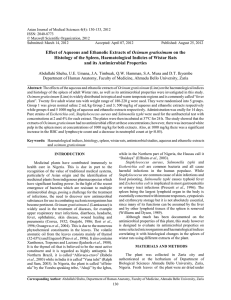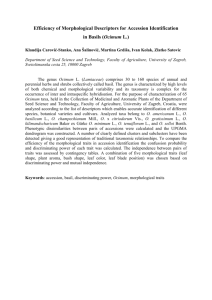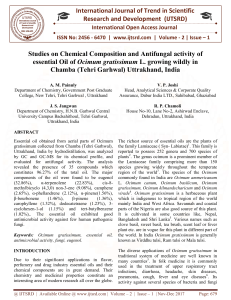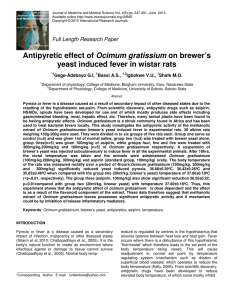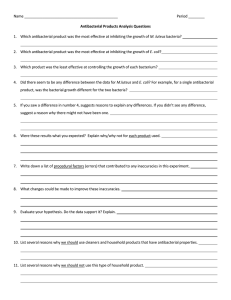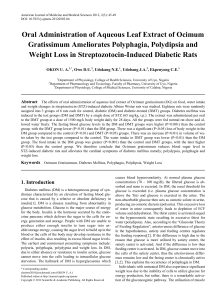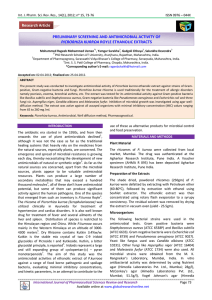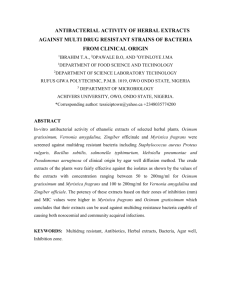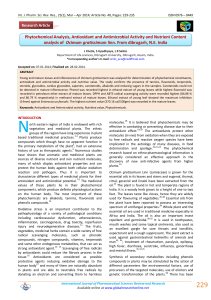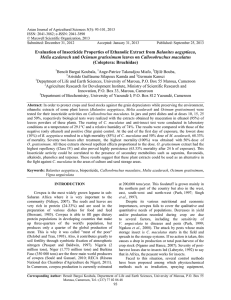Document 13309032
advertisement
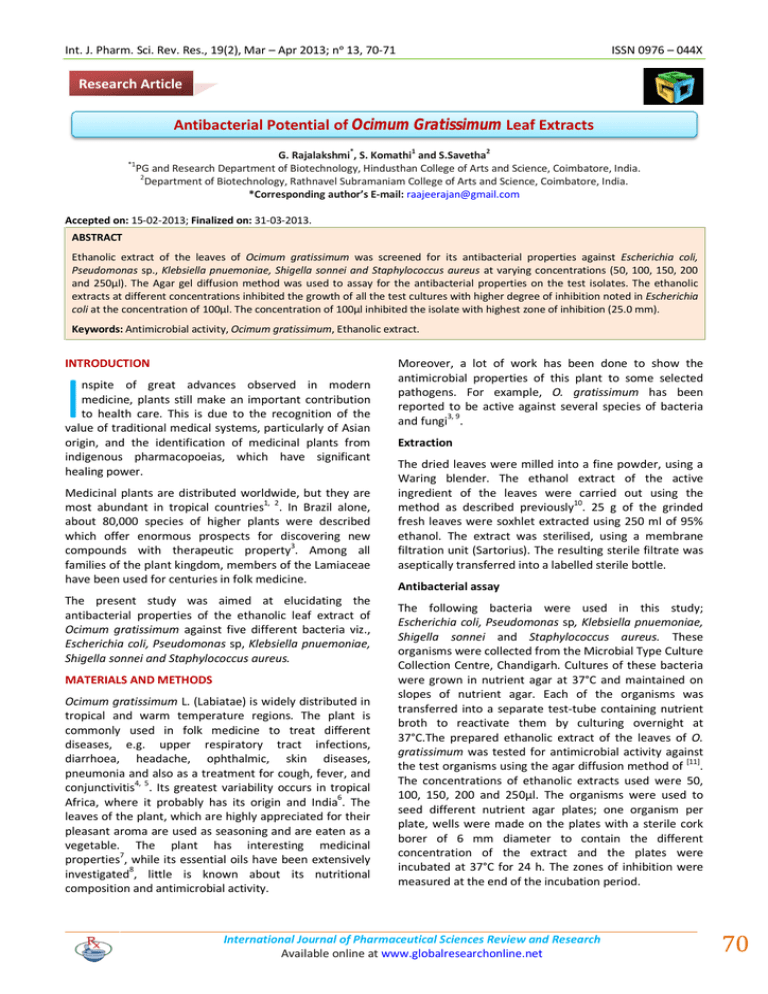
Int. J. Pharm. Sci. Rev. Res., 19(2), Mar – Apr 2013; nᵒ 13, 70-71 ISSN 0976 – 044X Research Article Antibacterial Potential of Ocimum Gratissimum Leaf Extracts * *1 1 2 G. Rajalakshmi , S. Komathi and S.Savetha PG and Research Department of Biotechnology, Hindusthan College of Arts and Science, Coimbatore, India. 2 Department of Biotechnology, Rathnavel Subramaniam College of Arts and Science, Coimbatore, India. *Corresponding author’s E-mail: raajeerajan@gmail.com Accepted on: 15-02-2013; Finalized on: 31-03-2013. ABSTRACT Ethanolic extract of the leaves of Ocimum gratissimum was screened for its antibacterial properties against Escherichia coli, Pseudomonas sp., Klebsiella pnuemoniae, Shigella sonnei and Staphylococcus aureus at varying concentrations (50, 100, 150, 200 and 250µl). The Agar gel diffusion method was used to assay for the antibacterial properties on the test isolates. The ethanolic extracts at different concentrations inhibited the growth of all the test cultures with higher degree of inhibition noted in Escherichia coli at the concentration of 100µl. The concentration of 100µl inhibited the isolate with highest zone of inhibition (25.0 mm). Keywords: Antimicrobial activity, Ocimum gratissimum, Ethanolic extract. INTRODUCTION I nspite of great advances observed in modern medicine, plants still make an important contribution to health care. This is due to the recognition of the value of traditional medical systems, particularly of Asian origin, and the identification of medicinal plants from indigenous pharmacopoeias, which have significant healing power. Medicinal plants are distributed worldwide, but they are most abundant in tropical countries1, 2. In Brazil alone, about 80,000 species of higher plants were described which offer enormous prospects for discovering new compounds with therapeutic property3. Among all families of the plant kingdom, members of the Lamiaceae have been used for centuries in folk medicine. The present study was aimed at elucidating the antibacterial properties of the ethanolic leaf extract of Ocimum gratissimum against five different bacteria viz., Escherichia coli, Pseudomonas sp, Klebsiella pnuemoniae, Shigella sonnei and Staphylococcus aureus. MATERIALS AND METHODS Ocimum gratissimum L. (Labiatae) is widely distributed in tropical and warm temperature regions. The plant is commonly used in folk medicine to treat different diseases, e.g. upper respiratory tract infections, diarrhoea, headache, ophthalmic, skin diseases, pneumonia and also as a treatment for cough, fever, and conjunctivitis4, 5. Its greatest variability occurs in tropical 6 Africa, where it probably has its origin and India . The leaves of the plant, which are highly appreciated for their pleasant aroma are used as seasoning and are eaten as a vegetable. The plant has interesting medicinal 7 properties , while its essential oils have been extensively 8 investigated , little is known about its nutritional composition and antimicrobial activity. Moreover, a lot of work has been done to show the antimicrobial properties of this plant to some selected pathogens. For example, O. gratissimum has been reported to be active against several species of bacteria and fungi3, 9. Extraction The dried leaves were milled into a fine powder, using a Waring blender. The ethanol extract of the active ingredient of the leaves were carried out using the method as described previously10. 25 g of the grinded fresh leaves were soxhlet extracted using 250 ml of 95% ethanol. The extract was sterilised, using a membrane filtration unit (Sartorius). The resulting sterile filtrate was aseptically transferred into a labelled sterile bottle. Antibacterial assay The following bacteria were used in this study; Escherichia coli, Pseudomonas sp, Klebsiella pnuemoniae, Shigella sonnei and Staphylococcus aureus. These organisms were collected from the Microbial Type Culture Collection Centre, Chandigarh. Cultures of these bacteria were grown in nutrient agar at 37°C and maintained on slopes of nutrient agar. Each of the organisms was transferred into a separate test-tube containing nutrient broth to reactivate them by culturing overnight at 37°C.The prepared ethanolic extract of the leaves of O. gratissimum was tested for antimicrobial activity against the test organisms using the agar diffusion method of [11]. The concentrations of ethanolic extracts used were 50, 100, 150, 200 and 250µl. The organisms were used to seed different nutrient agar plates; one organism per plate, wells were made on the plates with a sterile cork borer of 6 mm diameter to contain the different concentration of the extract and the plates were incubated at 37°C for 24 h. The zones of inhibition were measured at the end of the incubation period. International Journal of Pharmaceutical Sciences Review and Research Available online at www.globalresearchonline.net 70 Int. J. Pharm. Sci. Rev. Res., 19(2), Mar – Apr 2013; nᵒ 13, 70-71 RESULTS AND DISCUSSION Following the extraction of the leaves of O. gratissimum using ethanol, the antimicrobial activities of the extract against various bacteria were determined. Table 1 shows the antimicrobial activity of the different concentration of the extract on the selected bacteria. Of all the different concentrations used, 100µl inhibited the growth of the Escherichia coli with diameter of zone of inhibition of 25.0mm and 150µl inhibited the growth of Klebsiella pneumoniae with an inhibitory zone of 22.0mm. The anti-diarrhoeal activities of leaf extracts of O. gratissimum investigated by disc diffusion and tube 12 dilution methods have been reported . These authors have shown that the extracts were active against Aeromonas sobria, E.coli, P. shigelloides, S. typhi and S. ISSN 0976 – 044X dysenteriae. They have also shown that the MIC for those organisms ranged from 8 to 50 mg/ml, while the MBC were from 8 to 62 mg/ml. Recent studies on Ocimum gratissimum proved to be a useful medication for people living with Human Immuno deficiency Virus (HIV), and Acquired Immuno Deficiency Syndrome virus (AIDS)13. The volatile oil also stops spasm, the hyperactivity of the gastrointestinal tract, by combining with the antibacterial activity and thus lowers the amount of times the muscle of the stomach and gastrointestinal tracts contracts stopping the diarrhoea13 that are usually adverse for most other pathogenic bacteria. It can be isolated from soil, silage and other environmental sources14. Table 1: Antibacterial activity of ethanolic leaf extract of Ocimum gratissimum Concentration of extract (µl) 50 100 150 200 250 Escherichia coli 20 25 27 28 30 Zone of inhibition (mm) K.pneumoniae Pseudomonas sp Shigella sonnei 18 15 16 21 16 17 22 18 19 24 19 20 26 20 21 The study has showed that the ethanolic leaf extracts of Ocimum gratissimum exhibited antibacterial effect against the tested isolates. The use of this plant and its derivatives for the primary purpose of treating diseases will be of interest for further study. REFERENCES 1. Calixto, JB, Efficacy, safety, and quality control, marketing regulatory guidelines for herbals (Phytotherapeutic agents), Brazilian Journal of Medical Biology Research, 33, 2000, 179-189. 2. Lewis, EM, Should we be concerned about herbal remedies, Journal of Ethnopharmacology, 75, 2001, 141-164. 3. Nakaruma CV, Nakaruma TU, Bando E, Melo AFN, Cortez DAG, Diaz Filho BP, Antibacterial activity of Ocimum gratissimum L. essential Oil. Mem. Inst. Oswardo Cruz, 94, 1999, 675-578. 4. Correa MP, Dicionário das plantas úteis do Brasil, IBDF, Ministério da Agricultura, Rio de Janeiro, 1932, 63. 5. Onajobi FD, Smooth muscle contracting lipid soluble principles in chromatographic fractions of Ocimum gratissimum, Journal of Ethnopharmacology, 18, 1986, 3-11. 6. Osuji PO, Fernandez Riviera A, Odenyo, RJ and A Lahlou – Kassi, Improving fibre Utilisation and Protein Supply in Animals Fed Poor Quality Roughages, ILRI Nutrition research and Plans, In: Rumen Ecology Research and Planning, Wallace, International Livestock Research Institute, Addis Ababa, 1, 1995, 1 – 22. Staph. Aureus 15 17 18 19 21 7. Gill LS, Ethnomedical Uses of Plants in Nigeria, Uniben Press, Benin City, 1, 1992, ISBN: 978 – 2027. 8. Simon J, Quinn J, Murray R, Basil, A source of essential oils. In: Advances in new crops, Janick J and Simon JE, Timber Press, Portland, 1990, 484 – 489. 9. Nakaruma CV, Nakaruma TU, Bando E, Melo AFN, Cortez DAG, Diaz Filho BP, Antibacterial activity of Ocimum gratissimum L. essential Oil, Mem, Inst, Oswardo Cruz, 94,1999, 675-578. 10. Nwosu, MO, Okafor JJ, 1995 Preliminary studies of the antifungal activities of some medicinal plants against Basidiobulus and some pathogenic fungi, Mycoses, 38, 1995, 191-195. 11. Harbone, NV, Phytochemical methods, A guide to modern techniques of plant analysis, 2nd Edition, Chapman and Hall London, 1994, 425. 12. Navarro V, Villareal ML, Rojas G, Lozoya X, Antimicrobial evaluation of some plants used in Mexican traditional medicine for the treatment of infectious diseases, Journal of Ethnopharmacology, 53, 1966, 143-147. 13. Ilory M, Sheteolu AO, Omonibgehin EA, Adeneye AA, Antidiarrhoeal activities of Ocimum gratissimum (Lamiaceae), Journal of Diarrhoeal Disease Research, 14,1996, 283-285. 14. Elujoba AA, Studies on the antidiarrhoea activity of Ocimum gratissimum, 2000, University of Ile Ife Press. 15. Patrick RM, Ellen JB, Michael PE, Fred LT, Robert HY, Listeria In: th Manual of Clinical Microbiology, 6 ASM Press, Washington DC, 1995, 341-347. Source of Support: Nil, Conflict of Interest: None. International Journal of Pharmaceutical Sciences Review and Research Available online at www.globalresearchonline.net 71
